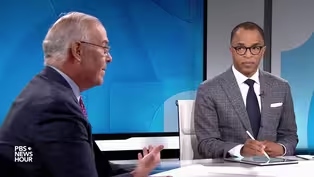
Fed blames bank collapse on mismanagement, oversight failure
Clip: 4/28/2023 | 6m 8sVideo has Closed Captions
Fed blames mismanagement and oversight failures for Silicon Valley Bank collapse
The Federal Reserve issued a stinging report on the historic collapse of Silicon Valley Bank. The analysis notes that while the collapse was a “textbook case of mismanagement” by bank officers, the Fed said its regulators missed clear danger signs as the bank ballooned in size and acted much too slowly on the problems they did identify. William Brangham discussed the report with Jeanna Smialek.
Problems playing video? | Closed Captioning Feedback
Problems playing video? | Closed Captioning Feedback
Major corporate funding for the PBS News Hour is provided by BDO, BNSF, Consumer Cellular, American Cruise Lines, and Raymond James. Funding for the PBS NewsHour Weekend is provided by...

Fed blames bank collapse on mismanagement, oversight failure
Clip: 4/28/2023 | 6m 8sVideo has Closed Captions
The Federal Reserve issued a stinging report on the historic collapse of Silicon Valley Bank. The analysis notes that while the collapse was a “textbook case of mismanagement” by bank officers, the Fed said its regulators missed clear danger signs as the bank ballooned in size and acted much too slowly on the problems they did identify. William Brangham discussed the report with Jeanna Smialek.
Problems playing video? | Closed Captioning Feedback
How to Watch PBS News Hour
PBS News Hour is available to stream on pbs.org and the free PBS App, available on iPhone, Apple TV, Android TV, Android smartphones, Amazon Fire TV, Amazon Fire Tablet, Roku, Samsung Smart TV, and Vizio.
Providing Support for PBS.org
Learn Moreabout PBS online sponsorshipGEOFF BENNETT: The Federal Reserve today issued a stinging report about the multiple failures that led to the historic collapse of Silicon Valley Bank last month.
As William Brangham reports, the main targets of the report?
The Fed's own regulators.
WILLIAM BRANGHAM: The Federal Reserve's report says Silicon Valley Bank collapsed because of a -- quote -- "textbook case of mismanagement."
But bank executives, by -- but it was especially critical of its own regulators, alleging they missed clear danger signs as the bank ballooned in size and acted much too slowly on the problems they did identify.
For more on this regulatory autopsy, we're joined by economics reporter Jeanna Smialek.
She covers the Federal Reserve for The New York Times.
Thank you so much for being here.
Before we get to how regulators failed, can you remind us of what mistakes that the executives at Silicon Valley Bank did that basically imperiled the entire banking system?
JEANNA SMIALEK, The New York Times: Yes, so they made two big buckets of mistakes, I would say.
The first is that they had a huge chunk of their deposit base in really, really big deposits, over the $250,000 limit that the government ensures.
And that meant that, when depositors got nervous, they were much more likely to try and pull all of that money out.
So that was mistake number one.
Mistake number two is that they made what was essentially a bet that interest rates would stay low for a really long time.
They invested in securities that were pretty predicated on that.
And when that didn't happen, when the Fed instead raised interest rates to try and control inflation, the bank was facing big losses.
And so that combination of decisions really was pretty fatal for this bank, because when the bank was facing these big losses, its nervous depositors took their money and ran.
WILLIAM BRANGHAM: So this is now touching on the report that came out today.
Federal regulators, who are supposed to have eyes on this particular bank and looking out for the exact things that you're describing, seemed to really drop the ball.
What did this report say that they failed to do?
JEANNA SMIALEK: It was a whole range of failures.
But I think that they really boiled down to failing to recognize the full extent of the problems and failing to follow up on the problems that were recognized.
So it's the case that the supervisors at the San Francisco Fed and across the Fed system were aware of some of these issues, and they pointed them out, and they flagged them.
But what they didn't do was act decisively enough to get the management at this bank to deal with the problems, to make them go away, to take care of them before they became lethal to the institution.
And so the Fed report was very critical of the Fed itself for failing to achieve that, that goal of making this institution safer.
WILLIAM BRANGHAM: Is it clearer from this report whether or not they had -- was it a lack of will to act?
Was it a lack of authority to step in and say, hey, you guys, there's multiple fires going on here, we need to put these out?
JEANNA SMIALEK: Yes, that's a great question.
I think it was actually some mixture.
So what we saw under the Trump administration and over the last few years was a real shift in tone around how banks ought to be supervised, how they ought to be regulated.
And this was bank of just the sort of size that that shift in tone apply to.
And so rules applying to banks, in sort of this mid -- what we call a midsize range, had become less onerous.
And that probably mattered in this case.
The other thing that mattered was just, I think, on-the-ground supervision.
The supervisors, for whatever reason -- and the report is not super clear on this -- didn't feel empowered to really say, hey, this is a problem, we need to deal with it now, and the regulations themselves weren't sort of nimble enough to allow them to address this stuff in a really rapid and forceful way.
And so I think we're going to see a lot of changes both on the way that banks are overseen on a day-to-day basis and in the way that they are regulated coming out of this episode.
WILLIAM BRANGHAM: Michael Barr, who's the Fed oversight chief, who drafted much of this report, calls for some of these reforms that you're talking about, what does he want to see done?
And how likely are those to be implemented?
JEANNA SMIALEK: Yes, I think it was a very ambitious wish list that he put out today.
But the thing is, the Fed actually has quite a lot of discretion when it comes to the kinds of things he wants to see.
So, for example, he would like for the Fed to reconsider how it is overseeing banks that have more than $100 billion in assets.
The Fed has pretty wide discretion to take a closer look at those -- that group of banks.
And so I think it'll take a couple of years, but it's likely that we're going to see some changes there.
Similarly, it seems like the supervisors are in for a sort of more aggressive approach to banks going forward.
I think stress tests, which are sort of the annual health checkups these banks get, could get another look.
I think it's going to be a vast array of changes.
And we got a lot of e-mails from bank lobbyists this afternoon expressing distress at these changes.
So I think, to the extent that that's a signal, it seems like these could be pretty real.
WILLIAM BRANGHAM: Just in the last 30 seconds we have I want to ask you about this other bank in Northern California, First Republic Bank.
Lots of concerns about this bank cratering.
Its stock has dropped, I think it's 97 percent over the year, dropped over 40 percent, I believe, today.
Concerns that the FDIC might take it over.
What is going on with that bank?
JEANNA SMIALEK: That bank is clearly on its last legs.
It is in a lot of trouble.
And it has been in a lot of trouble all week.
Here in the media, we have all kind of been playing the, will they, won't they?
When will this bank potentially go into receivership?
Reuters has been reporting that it could be imminent, that the government could take this bank over sort of any minute now.
I think that it's an open question exactly there timing will be.
But it seems like First Republic is clearly heading for some kind of big change.
I think that the bank has a lot of problems.
It has seen a huge deposit outflow over the last week-and-a-half, two weeks, three weeks.
And it probably is not going to be able to weather that.
So it's developing story.
WILLIAM BRANGHAM: On its last legs.
Jeanna Smialek of The New York Times, thank you so much.
JEANNA SMIALEK: Thank you.
Battles over reproductive, transgender rights in states
Video has Closed Captions
Clip: 4/28/2023 | 5m 47s | Battles over reproductive, transgender rights fought in state legislatures (5m 47s)
Brooks and Capehart on the possible Biden-Trump rematch
Video has Closed Captions
Clip: 4/28/2023 | 9m 58s | Brooks and Capehart on the possible Biden-Trump rematch and Tucker Carlson's ouster (9m 58s)
Judy Blume describes latest wave of book bans and censorship
Video has Closed Captions
Clip: 4/28/2023 | 7m 51s | The new film "Are You There, God? It's Me, Margaret," is shining a spotlight on Judy Blume (7m 51s)
Obstacles prevent homeless veterans from finding housing
Video has Closed Captions
Clip: 4/28/2023 | 8m 59s | The obstacles preventing homeless veterans from finding housing in Los Angeles (8m 59s)
Russian missile and drone attacks kill civilians in Ukraine
Video has Closed Captions
Clip: 4/28/2023 | 6m 11s | Russian attacks kill more civilians as Ukraine prepares for a major counteroffensive (6m 11s)
Providing Support for PBS.org
Learn Moreabout PBS online sponsorship
- News and Public Affairs

FRONTLINE is investigative journalism that questions, explains and changes our world.

- News and Public Affairs

Amanpour and Company features conversations with leaders and decision makers.












Support for PBS provided by:
Major corporate funding for the PBS News Hour is provided by BDO, BNSF, Consumer Cellular, American Cruise Lines, and Raymond James. Funding for the PBS NewsHour Weekend is provided by...




